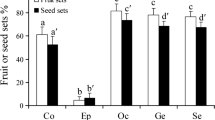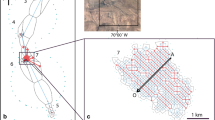Abstract
Clonally reproducing hemicryptophytic rosette plants are common in the alpine belt. However, their demography and, indirectly, their growth and reproductive strategy in these harsh conditions were rarely studied. We analysed the morphology, clonal reproduction and demography of one such species, Leontopodium alpinum, in two populations of the Swiss Alps. The species forms small colonies of 1–5 (maximum 30) sterile rosettes with a few flowering stalks. After flowering, the apical meristem dies and one or two new axillary buds grow below the previous rosette in the following year, developing into short rhizomes (<2 cm), which decay after 4 years. The new stalk produces sterile rosettes before flowering after 2–4 years, depending on climatic conditions. The apical meristem often dies during the sterile stage, and is replaced by a new axillary bud. Levkovitch matrices on two stages (sterile and flowering rosettes) showed that rosette survival and clonal reproduction maintain long-lived populations (λ = 0.96). Elasticities indicated that a change in the survival of sterile rosettes had the strongest effect on population dynamics, and this stage lasts, on average, 6.8 years at 2,480 m. Altogether, L. alpinum is following Tomlinson’s architectural model. This growth form appears perfectly adapted to harsh alpine conditions: the clonal ramification ensures longevity to genets and the semelparous behaviour of the rosettes allows an efficient flowering, whatever the climatic conditions. L. alpinum appears to follow a common growth model among rosette possessing hemicryptophytes in the alpine belt.





Similar content being viewed by others
References
Aeschimann D, Lauber K, Moser DM, Theurillat J-P (2004) Flora alpina. Belin, Paris
Aeschimann D, Rasolofo N, Theurillat J-P (2012) Analyse de la flore des Alpes. 3: biologie et phénologie. Candollea 67:5–21
Arlettaz R, Schaub M, Fournier J, Reichlin TS, Sierro A, Watson JEM, Braunisch V (2010) From publications to public action: when conservation biologists bridge the gap between research and implementation. Bioscience 60:835–842
Barot S, Gignoux J, Legendre S (2002) Stage-classified matrix models and age estimates. Oikos 96:56–61
Bliss LC (1971) Arctic and alpine plant life cycles. Annu Rev Ecol Evol S 2:405–438
Callaghan TV (1976) Growth and population dynamics of Carex bigelowii in an alpine environment. Oikos 27:402–413
Caswell H (2001) Matrix population models. Sinauer Associates Inc., Sunderland
de Kroon H, Plaisier A, van Groenendael J, Caswell H (1986) Elasticity: the relative contribution of demographic parameters to population growth rate. Ecology 67:1427–1431
de Witte LC, Scherrer D, Stöcklin J (2011) Genet longevity and population age structure of the clonal pioneer species Geum reptans based on demographic field data and projection matrix modelling. Preslia 83:371–386
Delarze R, Gonseth Y (2008) Guide des milieux naturels de la Suisse. Rossolis, Bussigny
Dweck AC (2004) A review of Edelweiss. SÖFW J 130:65–68
Erhardt A (1993) Pollination of edelweiss, Leontopodium alpinum. Bot J Linn Soc 111:229–240
Erhlén J, Lehtilä K (2002) How perennial are perennial plants? Oikos 98:308–322
Erschbamer B, Winkler J (1995) Shoot and leaf demography of Carex curvula ssp. curvula and Carex curvula ssp. rosae in the Central Alps. J Veg Sci 6:593–598
Forbis TA, Doak DF (2004) Seedling establishment and life history trade-offs in alpine plants. Am J Bot 91:1147–1153
García MB, Picó FX, Ehrlén J (2008) Life span correlates with population dynamics in perennial herbaceous plants. Am J Bot 95:258–262
Hamilton NRS, Schmid B, Harper JL (1987) Life-history concepts and the population biology of clonal organisms. Proc R Soc London 232:35–57
Ischer M, Dubuis A, Keller R, Vittoz P (2014) A better understanding of the ecological conditions for Leontopodium alpinum Cassini in the Swiss Alps. Folia Geobot. doi:10.1007/s12224-014-9190-8
Keller R, Vittoz P (2010) Premiers résultats d’un suivi de l’Edelweiss (Leontopodium alpinum Cass.) dans le val Ferret (Valais). Bull Murithienne 127:29–44
Kim E, Donohue K (2011) Demographic, developmental and life-history variation across altitude in Erysimum capitatum. J Ecol 99:1237–1249
Klimeš L, Klimešová J, Hendriks R, van Groenendael J (1997) Clonal plant architecture: a comparative analysis of form and function. In: de Kroon H, van Groenendael J (eds) The ecology and evolution of clonal plants. Backhyus Publ, Leiden, pp 1–29
Körner C (2003) Alpine plant life. Springer, Berlin
Kuss P, Rees M, Aegisdóttir HH, Ellner SP, Stöcklin J (2008) Evolutionary demography of long-lived monocarpic perennials: a time-lagged integral projection model. J Ecol 96:821–832
Marcante S, Winkler E, Erschbamer B (2009) Population dynamics along a primary succession gradient: do alpine species fit into demographic succession theory? Ann Bot 103:1129–1143
Matteodo M, Wipf S, Stöckli V, Rixen C, Vittoz P (2013) Elevation gradient of successful plant traits for colonizing alpine summits under climate change. Environ Res Lett 8:024043
Molau U (1997) Age-related growth and reproduction in Diapensia lapponica, an arctic-alpine cushion plant. Nord J Bot 17:225–234
Morris WF, Doak DF (1998) Life history of the long-lived gynodioecious cushion plant Silene acaulis (Caryophyllaceae), inferred from size-based population projection matrices. Am J Bot 85:784–793
Morris WF, Doak DF (2002) Quantitative conservation biology: theory and practice of population viability analysis. Sinauer, Sunderland
Morris WF, Doak DF (2004) Seedling establishment and life history trade-offs in alpine plants. Am J Bot 91:1147–1153
Pellissier L, Fournier B, Guisan A, Vittoz P (2010) Plant traits co-vary with altitude in grasslands and forests in the European Alps. Plant Ecol 211:351–365
Rey C, Rey S, Vouillamoz J, Baroffio C, Roguet D (2011) L’Edelweiss—Reine des, fleurs edn. du Belvédère, Fleurier
Salguero-Gómez R, Casper BB (2010) Keeping plant shrinkage in the demographic loop. J Ecol 98:312–323
Silvertown J, Franco M, Pisanty I, Mendoza A (1993) Comparative plant demography—relative importance of life-cycle components to the finite rate of increase in woody and herbaceous perennials. J Ecol 81:465–476
Stubben CJ, Milligan BG (2007) Estimating and analyzing demographic models using popbio package in R. J Stat Softw 22:11
Tomlinson PB (1983) Tree architecture: new approaches help to define the elusive biological property of tree form. Am Sci 71:141–149
Wagenitz G (1979) Compositae I: Allgemeiner Teil, Eupatorium-Achillea. In: Hegi G, Conert HJ, Hamann U, Schultze-Motel W, Wagenitz G (eds) Illustrierte Flora von Mitteleuropa. Band VI, Angiospermae Dicotyledones 4, Teil 3, vol 2. Paul Parey, Berlin, pp 133–136
Weppler T, Stoll P, Stöcklin J (2006) The relative importance of sexual and clonal reproduction for population growth in the long-lived alpine plant Geum reptans. J Ecol 94:869–879
Worley AC, Harder LD (1996) Size-dependent resource allocation and costs of reproduction in Pinguicula vulgaris (Lentibulariaceae). J Ecol 84:195–206
Young TP, Augspurger CK (1991) Ecology and evolution of long-lived semelparous plants. Trends Ecol Evol 6:285–289
Acknowledgments
The authors thank the Fondation Ignace Mariétan, the municipality of Orsières and the Service des Forêts et du Paysage (Valais) who helped with financial support. We are grateful to J. Stöcklin and two anonymous reviewers for their useful comments on a first draft of this manuscript.
Author information
Authors and Affiliations
Corresponding author
Electronic supplementary material
Below is the link to the electronic supplementary material.
35_2014_142_MOESM1_ESM.pdf
Supplementary material 1 “Additional supporting information in the online version ofthis article (see “Supplementary Material”) contains the following:”and then list the files with a descriptive name, e.g. “ESM_1 – Globaloverview, ESM_2 – Detailed list of topics”. (PDF 221 kb)
Rights and permissions
About this article
Cite this article
Keller, R., Vittoz, P. Clonal growth and demography of a hemicryptophyte alpine plant: Leontopodium alpinum Cassini. Alp Botany 125, 31–40 (2015). https://doi.org/10.1007/s00035-014-0142-y
Received:
Accepted:
Published:
Issue Date:
DOI: https://doi.org/10.1007/s00035-014-0142-y




